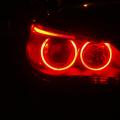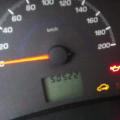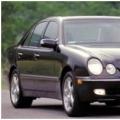Brake caliper - one of the most important details brake system car. The life of people in the car depends on the health of the brake calipers. Moreover, stopping support - The most "dynamically developing" part of the brake system. This is due to tough competition between car manufacturers trying to attract potential buyers, including, and by increasing the maximum speed.
History of application of disc brake mechanisms
It is believed that the first model was developed by the Englishman Frederick Lanchester approximately in 1890. In his scheme, the caliper, compressing, was first used. However, at that time, the materials had not yet existed for mass production disc brakesAnd about the design was safely forgotten. The world's risk brake popularity is obliged to the aviation industry. During World War II, they were installed on the chassis of combat aircraft. At the beginning of the fifties, disc brakes began to actively apply on sports cars, and after some time began to install and on serial models. For the first time, disc brakes in the standard modification were installed on the front axle.Device, principle of operation and types of brake calipers. Pros and cons.
In the process of evolution of disc brakes, two separate "branches" were revealed - brake calipers of fixed design and with the so-called "floating bracket". Brake caliper fixed designFixed calipers chronologically appeared earlier than the brake mechanisms with a floating bracket. A fixed-type caliper consists of a metal case and located symmetrically from two sides from brake disc Working cylinders. The case is rigidly fixed or rear suspension. When you press the brake, the pads are pressed to the disk simultaneously on both sides. In the diluted state, the pads are held in place with springs of a special form. To ensure simultaneous triggering of the pistons, the brake fluid is supplied with a branched tube system simultaneously into all cylinders. Due to the fact that several cylinders are used in the mechanism, fixed brakes have great efficiency. Them put on cars possessing large mass (for example W463) or. The devices of this type are produced by specialized sports spare parts manufacturing companies such as Brembo. Brake caliper with floating brakeThe brake mechanisms of this type differ from fixed by the fact that on one side of the shoe is constantly in one place. Floating brace caliper consists of a bracket and cylinder housing fixed with inner wheels. In the cylinder case, one (less often two) piston is installed. When braking, the piston presses onto the second block, which is in front of it. Thus, the block move first, and when it is pressed against the disc plane, the floating caliper bracket begins to move towards the piston on the guide fingers, as a result of which the second, external shoe is pressed. The mechanism of this type is easier, cheaper in production and has a small size . The brakes of this type were distributed on inexpensive cars equipped with full-time discs of small diameter.Issues of operation and modernization of brake calipers
A car enthusiast, challenged for the car independently, it is important to know the car.1. It is necessary at least once a month inspecting the elements of the brake system, including brake calipers, for leaking brake fluid. When inspecting brake calipers, you should pay attention to the working cylinder piston boot and the location of the hose connections with a caliper. If tracks are detected, urgently find their cause and eliminate it.2. No less often in two years of operation of the car fully change the brake fluid in the system. Since it has such a property as hygroscopicity - the ability to absorb moisture from the air. The presence of water in the composition T, it is, first - wadded and naughty brakes, secondly - non-revealed connections of tubes and brake hoses - due to the appearance of corrosion traces. Consequence undime replacement The brake fluid can be the appearance of the piston in the working brake cylinder. To eliminate this malfunction, the cylinder will have to be replaced. All modern brake pads are equipped with wear signaling devices. When replacing the pads, you need to pay attention to the uniformity of their wear. If the wear is uneven - then, most likely, the guide fingers of the floating bracket are hooked. To eliminate the fault, it is necessary to replace the lubricant and develop a guide sleeve.Modernization
Replacing brake calipers to more productive - the natural continuation of the tuning of the car, if the first stage has become. To enhance the brake system of the car, standard calipers are usually replaced by calipers with a large number of operating cylinders or calipers with a large diameter of the working cylinder. Such interventions, as a rule, occur paired with replacement brake discs On the wheels of the larger diameter and with an improved ventilation. Brake calipers with 4-12 piston mechanisms create a much greater clamping force, which is evenly and optimally distributed through the pad area. At the same time, with 8-12 piston calipers, four pads on the caliper are required. After replacing calipers, it is necessary to check the efficiency of the system on a special diagnostic stand.Disk systems have become increasingly more active, manufacturers had to look for a solution to one very relevant problem. The fact is that in the disk it is necessary to ensure that there is no expansion of the pads, but on the contrary - their compression. Consequently, the traditional design scheme turned out to be unsuitable. However, the solution was found quite quickly. The first effective device that received the name "brake caliper of the rear" appeared at the turn of the 50s and 1960s of the last century. How does it work and what is the features of its maintenance and repair?
Car rear brake caliper concept
The systematic development of discharging technologies has led to the fact that today the brake rear caliper can have two different principled design schemes:
- fixed;
- the design of the so-called "floating bracket".
Appointment of both schemes identically. They allow you to turn the brake caliper of the rear into the active element by pressing the pad to wheel Disk. But each of the designs has its own characteristics.
Fixed brake caliper design
Such a caliper consists of a metal central block, fixed on special and working cylinders with pistons, symmetrically placed on both sides of the brake disc. In the non-working block, the pads with springs are held in a parallel disk of the state at some distance from it. When you press the pedal coming simultaneously on a complex hose system, the pistons are activated, which compress the pads.
Such a constructive scheme is considered the most effective for disk systems and is successfully applied on vehicles with high engine power parameters. It is such a brake rear caliper installed on most SUVs, cars representative class and sports cars.
Floating bracket mechanism
The principled constructive difference between such a system from the traditional lies in the fact that one of the pads is always in a static position. The braking process is as follows:
- when you click on the pedal, the liquid has pressure on the piston brake cylinder;
- thanks free go. Brake rear caliper piston leaves the cylinder housing and presses on the second brake shoe;
- continuing its movement along a special guide, the bracket presses to the disk and the second brake block.
This scheme is often used quite often in various brands. passenger cars.  In particular, the rear brake caliper ("Opel" is no exception) most often has exactly the "floating" structural scheme.
In particular, the rear brake caliper ("Opel" is no exception) most often has exactly the "floating" structural scheme.
The importance of a good condition of the caliper
It goes without saying that the trouble-free operation of this car system directly affects the safety of the owner of the machine, passengers and other participants in the movement. Accordingly, the state of these elements requires increased attention to themselves. At the very first signs of problems in the work of the calipers, it is necessary to immediately access highly qualified specialists of the car service or maintenance station!
The most characteristic fault
The most common types of faults, which are subject to the brake rear caliper, are the following:
- Casting and corrosion of piston. As a result, the pressure of the brake fluid when the brake pedal is pressed in order to bring the piston in motion.
- The flow of sealing cuffs. This leads to insufficiently effective jams. In addition, the air can be hit in the system, which will lead to insufficiently correct braking of all wheels of the car.
- The failure of the anther. In this case, dust and dirt accumulate between the piston and the cylinder, which leads to the difficult go of the piston, as well as to the loss of fluid.
- Damage to the mobile bracket or its insufficient tightening. One of the most dangerous breakdowns. If, for example, the caliper brake rear right gets damage to the brake, then with a sharp braking, it may simply fall off. The fluid instantly turns outwards, which will inevitably lead to the failure of the system and on the other wheels.
Thus, careful control of the correct operation of the calipers is dictated by elementary considerations of common sense, its own security and instinct of self-preservation.

Professional diagnosis
Most effective way Avoid the problems listed above is a professional diagnosis produced by highly qualified specialists using a specialized tool and equipment. The diagnostic process includes, as a rule, two stages of work:
- Check the efficiency of the brake operation of each wheel. It is held on a special computer booth under the supervision of qualified experts.
- Visual examination of calipers. This operation provides for the need to remove rear wheels. The state of the bracket, hull, cylinders and anthers is checked. If damage is detected, the parts are subject to immediate replacement.
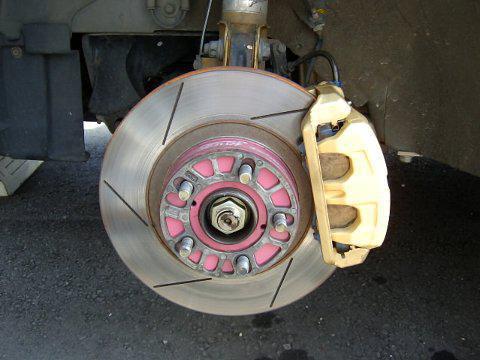
Independent diagnosis
If it is impossible professional diagnostic Caliper brake rear (left or right is not important) can be checked independently. True, the results of such an event may be approximate, and therefore you do not identify the problems in a timely manner.
Nevertheless, checking the serviceability of the brake system of the rear wheels is as follows:
- choose a smooth section of the road with good coating and with the minimum possible traffic intensity;
- the car accelerates to a speed of 30 km / h;
- when the specified speed is reached, the clutch is squeezed (or the neutral mode on the automatic transmission is turned on), and the brake pedal is sharply pressed into the floor.
If the machine retains the course stability, then the system is in order. If it begins to put it, this often indicates a caliper fault. Determine which side of the brake caliper rear is faulty, easy enough. The car always "leads" in the opposite direction.

Repair and replacement
Both diagnostic work and repair of brake calipers are strongly recommended to charge highly qualified specialists. In addition to the fact that they own all the necessary deep theoretical knowledge and rich practical experience, at their disposal also a wide arsenal of specialized tools and equipment.
As a rule, the repair of the rear brake stroke includes the replacement of anthers and cuffs, adding the brake fluid and enhancing the attachment of all structural elements. But this is the so-called maintenanceWith which the motorist himself can cope. But the cracks on the bracket or on the body of the working cylinder, damage to the guides, the deformation of the pistons require the intervention of specialists.
Depending on the manufacturer and car model, the rear wheels of the rear wheel calipers can have differences and certain nuances that should be remembered. So, for example, the caliper of the brake rear "Lacetti" and in its design, and concept, and the location of the parts is significantly different from the similar unit installed, say, toyota car Land Cruiser.. And since the serviceable and trouble-free operation of this system is a vital factor for any vehicleThe maintenance and repair of the rear brake caliper requires a high degree of preparation and appropriate qualifications.

Dismantling and replacing the details do it yourself
However, in the acute need to replace the rear brake caliper, it is possible to produce on its own. To do this, you will need to perform the following actions:
- under the front wheels you need to establish the anti-collective stops of a building brick or other items);
- after that, with the help of a jack, lift the back of the car;
- for security purposes under the back of the car, you will need to substitute the stops;
- after which you can dismantle the appropriate wheel;
- next, disconnect the drive (if any);
- remove the protective caps from the guides;
- by revealing the guides with the hexagon, carefully remove the caliper.
Important moment. If you need to complete the detail, it will be necessary to disconnect the brake hose. In order to prevent leakage of fluid, you should have a piece of rubber, cellophane or dense rags, which boil the hose hole. You must not forget about the need to connect it after installing a new item. Otherwise, the system will not work.

Periodicity of prevention and repair
Modern brake caliper is strong enough and reliable devicefailing and receiving serious damage relatively rarely. Nevertheless, in order to safety, the diagnosis of this most important unit is recommended to be carried out at least once every 6 months. And best of all trust the work of this type by qualified specialists. This, of course, will entail certain financial costs, but in return guarantees security and can even preserve human lives!
So, we found out how the brake caliper of the car is arranged and how it can be distributed independently. Successes!
Prevention and repair of brake calipers. The automotive brake system consists of several elements, each of them performs a specific function. The caliper is one of the most important elements in the brake system, it presses the pads to the disk during braking, it depends on how quickly the machine will stop.
Working caliper.
When braking, when pressing the pedal, the pressure in the brake line increases, this pressure is transmitted to the pistons of calipers. They supply pads to the disk and clamp the disk on both sides. Accordingly, friction occurs, rotation slows down, turning the energy of the movement into thermal energy, heats the caliper and pads. That is why the calipers should be strong, with good heat transfer, so as not to change their shape due to high temperatures.
If you heard the creak appeared when braking, it is a sign that the caliper can break or wear brake pads (recently installed pads can also creak.


Prevention of calipers.
Like any mechanisms, the calipers require prevention, namely:
- disassemble and lubricate;
- check the integrity of rubber seals (the length of the calipers service depends on their integrity);
- check the anthers so that the dirt does not fall into cylinders, scratching them and piston;
- lubricate calipers only with a special lubricant material (sold in specialized auto shops), lithol or graphite use is not worth it.

Front brake calipers - check and repair.
Before disassembling - assembling a caliper, purchase Repair Kit, stored in this way:
- sealing rings;
- anthers for piston;
- anthers for guides;
- special lubrication.
It is possible to use old caliper details if they have no damage.

Part of the first thing about how there are brake calipers than they differ and how they work, talk about a working brake cylinder and pads, arrange a small automobile order and see a lot of photos. Start from the brake disc.
Brake disk
 Brake disc with floating rotor Ferrari 430
Brake disc with floating rotor Ferrari 430
The brake disc, made of cast iron, is rigidly fixed on the wheel hub, that is, rotates with the wheel speed. Brake discs This is what appears in front of us when the wheel is removed.
 Front brake disc Ford Focus. St.
Front brake disc Ford Focus. St.
The brake disc takes on almost all thermal energy that is distinguished during braking. Therefore, HIS the main characteristic It is heat capacity and thermal conductivity. The latter in turn is also needed in order to quickly give heat environment - Heat the air. The disk should have sufficient rigidity to withstand the pressure of the pad and must carry frequent and strong temperature differences. In civil cars, drive discs from cast iron, which has a very low friction coefficient, which increases wear resistance. It would seem that in the brakes the friction coefficient should be large, but that everything ultimately rests on the coefficient of friction of tires with asphalt. And only where the tires allow, it makes sense to use discs from ceramics, carbon. But such discs will be noticeably faster.
The design distinguishes solid discs and ventilated (double). Solid pose a flat one-piece disk - such usually put on rear wheels budget machines.
 Solid rear brake disc
Solid rear brake disc
Validated discs are, in fact, two one-piece disks are connected by partitions. Valid disks are much better cooled due to air, which circulates between discs. On expensive discs, partitions are designed specifically to improve air circulation.
 BMW Front Brake Disk
BMW Front Brake Disk
To facilitate the weight, the hub part of the disk (bell) is made of smaller alloys (aluminum), and the rotor itself (working surface) is fastened with bolts. Moreover, the mount may not be tough and allow some axial offset of the working part of the disk - discs with a floating rotor.
 Composite Brake Disc Mitsubishi Evolution X
Composite Brake Disc Mitsubishi Evolution X
Washing discs help to remove hot gases from the rubbing surfaces of the pad and disk, and on the one hand, increase the surface area of \u200b\u200bthe disc (for better cooling), and on the other, the area of \u200b\u200bcontact with the disc is reduced, respectively, less heat is highlighted in the friction pair.
 Realized disk with notches. In the context, you can see the structure of the jumpers connecting two parts of the disk
Realized disk with notches. In the context, you can see the structure of the jumpers connecting two parts of the disk
Perforated discs have through and deaf holes and contribute better cooling disk. Also, on the one hand, they reduce the rigidity of the entire structure, and on the other hand, it is easier to carry the deformations associated with constant and rapid heating and cooling.
 Brake disk with perforation Aston Martin. wall clock
Brake disk with perforation Aston Martin. wall clock
 Comparison different species Disc
Comparison different species Disc
Brake disc, and rather its size directly affects minimum size wheel disks And indirectly on the rubber profile. The more brake disc is required, the more the wheel will be, because the disc itself and the caliper must fit into the wheel drive and still have a clearance for accessing air to cool and do not overheat the wheels themselves.
Caliper
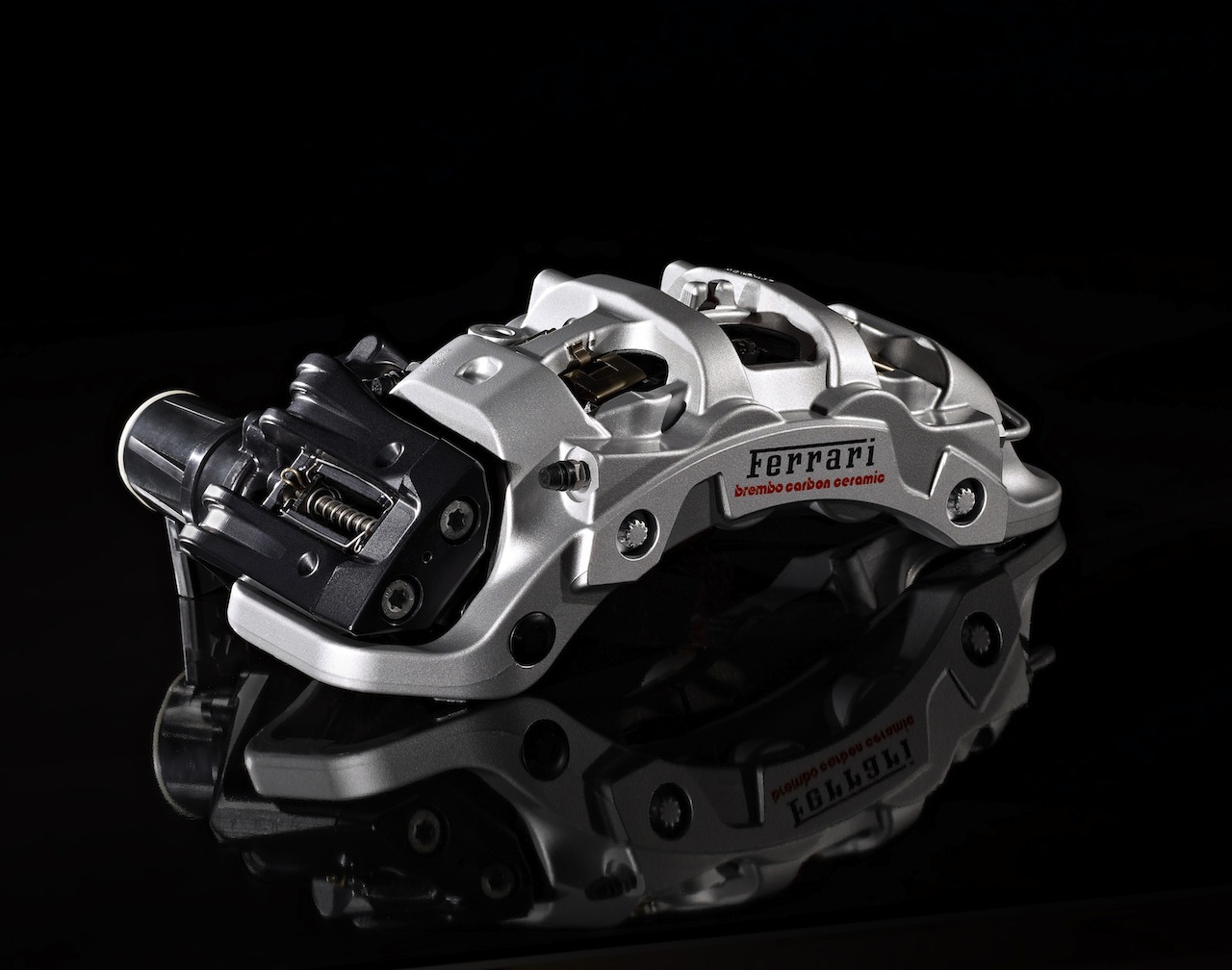 Brake Caliper Brembo "Extrema" for Ferrari Laferrari
Brake Caliper Brembo "Extrema" for Ferrari Laferrari
The task of the caliper is pressing the pads to the brake disc on both sides. On the front wheels, the caliper is attached to swivel fist. and still relative to the rotating brake disc. Pads to the disk presses the working cylinder (from one to six and eight), activated high pressure Brake fluid. Working cylinders can be on one side of the cylinder and both.
 Single-touch floating BMW caliper
Single-touch floating BMW caliper
AT ordinary machines The caliper is one working cylinder located on the inside. For racing machines It is well suited to a caliper with several working cylinders (multi-poulty), but racing rarely when braking takes place until a complete stop, usually it is necessary to quickly and effectively reset the speed (well, say, up to 90 km / h and take a steep twist). Several working cylinders are evenly pressed the block to the disk, and heat is distributed evenly. But such structures have less clamping force, due to the small size of the pistons and cylinders themselves. One large working cylinder develops greater effort than, for example, two or three small.
 Single-touch floating caliper with brake pads
Single-touch floating caliper with brake pads
Two designs are common - with floating and fixed caliper. In civil cars applies the first. Consists of two parts - the caliper itself and the guide pads.
 Pads in guide (without caliper)
Pads in guide (without caliper)
A floating caliper is fixed only along the axis of rotation of the brake disc (wheels) and can be freely moved perpendicular to it on the guides (fingers) fixed in the guide pads. This allows you to place one or more brake cylinders only on one side of the caliper, but at the same time have a uniform pressing of the pads to the disk from two sides. The piston of the working cylinder presses on the block, pressing it to the brake disc, while the piston caliper from the piston, which leads to the fit of the pads from the opposite side of the disk.  Two-position floating caliper assembly with guides and pads
Two-position floating caliper assembly with guides and pads
Fixed calipers are rigidly fixed relative to the disk and have from two to eight working cylinders located on different sides relative to the disk. Corporate caliper themselves, or cast one part.
 Four-position fixed monolithic caliper in section
Four-position fixed monolithic caliper in section
The caliper is attached to a swivel fist or directly or through special brackets.
 Fastening the caliper Honda Civic. (fixed with a composite four-position)
Fastening the caliper Honda Civic. (fixed with a composite four-position)
The caliper has two holes - for supplying the brake fluid and for pumping (usually placed on top, so that the air is easier to come out).
 Single Single Rear Caliper Kia Sorento.. The arrows marked the entrance port and the fitting for pumping (under the rubber cap)
Single Single Rear Caliper Kia Sorento.. The arrows marked the entrance port and the fitting for pumping (under the rubber cap)
Fixed calipers can be composite (the caliper has a longitudinal section and consists of two mirror halves) and monolithic. The first is easier to manufacture. In general, they have approximately the same strength, with composite, the stiffness of steel bolts connecting two parts of the aluminum caliper are added. (Moreover, the modulus of elasticity of steel increases with increasing temperature, while for aluminum it falls, but for expensive monolithic calipers, special alloys are used, which are not so much exposed to this).
 Monolithic fixed caliper
Monolithic fixed caliper
Two half of fixed calipers are connected by a tube for supplying brake fluid to the second half. It is usually located outside, but can pass on the channel and inside the caliper.
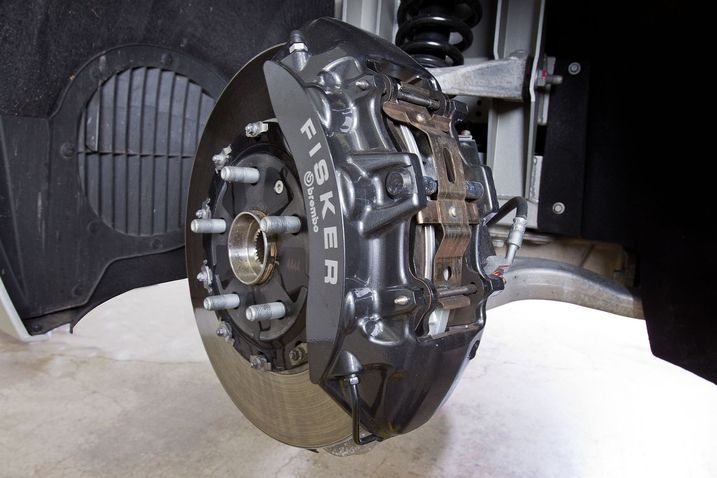 Composite six-piston fixed caliper. Bottom tube for connecting two half
Composite six-piston fixed caliper. Bottom tube for connecting two half
On a different machine, the location of the brake calipers relative to the disk wears, it would seem completely random character. What are the only configurations (the most common - the front caliper is shifted back, rear - forward, i.e. the caliper "look" at each other). In general, the brake caliper should be kept away from dust, dirt and water flying from the road, but this leads to an increase in the center of gravity (especially racing machines With huge and heavy calipers). Location front caliper Dictated by the location of the steering thrust and geometry of the suspension. The location of the calipers can be slightly affected by the longitudinal routing of the machine and the length of the brake line, which affects the speed of triggered brakes. Establishment should also be taken into account. Where it is important, you should consider the direction of air flows for cooling the brakes - whether the caliper or disk first cool the callery.

Working brake cylinder
 The cut of the working cylinder with the piston Chevrolet Corvette. Zr1
The cut of the working cylinder with the piston Chevrolet Corvette. Zr1
The working cylinder is a piston that goes in a drilled hole in the caliper. The piston presses directly on the brake shoe under the action of the pressure of the brake fluid. For sealing uses a rubber ring inserted into the recess in the wall of the piston (caliper). The piston itself is hollow, usually in the form of a glass, often covered with chrome to protect against corrosion. To protect against falling into the working cylinder dust and dirt, a boot is used, fixed by one side on the piston, and the other on the caliper. The boot is made of heat-resistant rubber.
 Piston of the working cylinder
Piston of the working cylinder
In multi-poult calipers (6 and above), it is customary to use working cylinders of different diameters, which increases to the back of the pad / caliper. That is, the back of the pad is pressed stronger. This allows you to achieve a more uniform wear of the block, helping to efficiently distribute heat. In addition, when braking the shoe is stepping, forming dust that accumulates to the back of the pad.
 Piston working cylinder. Such a piston design allows less heat to transmit brake fluid.
Piston working cylinder. Such a piston design allows less heat to transmit brake fluid.
Brake pads

The pad is a metal plate with a friction layer applied to it, which should be resistant to high temperatures. The friction coefficient of the friction layer in ordinary (civilian pads) does not exceed 0.4. It should be borne in mind that the high coefficient of friction in a pair of a block-disk leads to squealing in braking due to the emerging vibrations. For thermal insulation brake pad From the piston of the working cylinder and most importantly from the brake fluid, rubber or copper compositions are applied between the shoe and the piston. It also helps reduce the level of vibration and squeal.

Because of the high hardness (and fragility) of the friction layer on the pads apply notches. It is usually vertical (one or more depending on the pad) incision in the center that prevents cracking of the pad (due to the constant thermal expansion and narrowing), and also helps clean the rubbing surfaces from rust from the brake disc, dust, dirt and promotes the discovery. hot gases.

For a timely alert about wear of the pads, a mechanical wear indicator is installed. It is a thin metal plate, which, when wearing the pad, begins to touch the disk and publish WIGs when braking.
 On the upper pads, the wear indicator is clearly visible.
On the upper pads, the wear indicator is clearly visible.
In conclusion, consider a couple of photos and try to determine what's what.
 Front brakes Ford Focus 2012
Front brakes Ford Focus 2012
 This is a photo of the brakes of one of the Cadabrov. He likes to play checkered on MKAD and he has very cool brakes. Try to guess the car and the owner.
This is a photo of the brakes of one of the Cadabrov. He likes to play checkered on MKAD and he has very cool brakes. Try to guess the car and the owner.
In the second part, we will talk about the brake line, the brake fluid, we will understand the principle of operation of the main brake cylinder, the regulator and vacuum brake amplifier. In the third part, consider the design brake drums, parking brakeDifferences rear calipers And let's try to "open" the ABS block.
If you have noticed that the car in braking will noticeably lead to the right or left, and after the brake pedal is released, the front wheels (wheel) remain blocked, there is a brake disc overheating or the feeling that they are deformed - then signs of brake caliper faults, and you should pay close attention to caliper disk brake mechanism Vase. In particular, its pistons, cylinders and guides deserve special attention.
It should be borne in mind that similar brake caliper malfunctions may be caused by other reasons. Here are their list:
- Strong wear brake pads.
- Malfunction of the main brake cylinder.
- Availability aerial traffic In the hydraulic drive of the brake system.
- Damage to the brake disc.
Therefore, to localize the malfunction, it is necessary to make sure that all other nodes are in order and pump the braking system. Next, you will learn how to check the guide calipers.
Checking the guide caliper ("fingers") Lada Kalina (VAZ 1118)
If, after these events, the problem remains, you can go directly to diagnostics Caliper. Special attention in this case deserve a cylinder and guides ("fingers"), according to which the caliper moves when the piston is output from the cylinder to compress the pads. The first sign of bad work of the guides is their strongly contaminated surface that prevents the congestion of the caliper. It also indicates uneven wear of the inner and external - it should not exceed 5 mm.

If you find similar symptoms, the guide caliper is better replaced. Their cost in place with all the washers and anthers assembled is small and will not require special costs. Operation on their removal and installation of new "fingers" will take no more than an hour, subject to the replacement of all four guides. If desired (or the absence of spare parts), you can try to clean old guides.
If the inspection showed that the guides are in order, and wear the pads are uniform, attention should be transferred to caliper cylinders. First of all, it is worth considering them for leaks of the brake fluid. The presence of such testifies to the wear of the glands. In this case, the replacement of the caliper is required, since its repair at home is practically impossible with the required efficiency.
Thanks for the subscription!

If, when you press the brake pedal, the pistons do not leave the cylinders or do not return back after it is released, still pressing the pads to disks, this indicates their zaksay. In this case, you can try to restore normal work Caliper (see Article Prevention of brake calipers) Or immediately replace the caliper with the cylinder and the piston assembly.
Before checking the performance of the guides and pistons of the front calipers, be sure to check the remaining brake system elements whose fault may entail similar symptoms. When diagnosing brake calipers status, pay special attention to the state of the guides and pistons.

